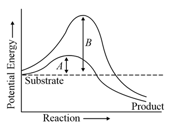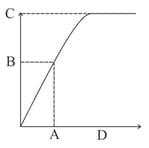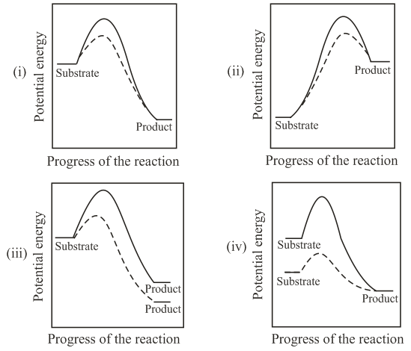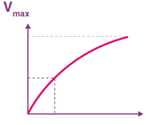Enzymes often have additional parts in their structures that are made up of molecules other than proteins. When this additional chemical part is an organic molecule, it is called
Important Questions on Chemical Constituents of Living Cell
Study the following
| (I) | value | Affinity of the enzyme | Inverse measure enzyme affinity |
| (II) | Hydrolases | bonds | Linking compounds |
| (III) | Transferases | Transfer of a group | Inhibitor of reaction |
| (IV) | Emil Fisher | Lock and key hypothesis | Formation of ES complex |
The correct combinations are

The graph below depicts the velocity of an enzyme-catalyzed reaction vs. substrate concentration. Identify the alphabets with the correct descriptions.

I. Enzyme activity
II. Substrate concentration at maximum velocity
III. Substrate concentration at which half of the maximum velocity
IV. Half of the maximum velocity
If an enzyme reaction follows the Michaelis Menten kinetics represented by the equation:
Where is the initial reaction velocity, is the maximal reaction velocity, is the Michaelis constant, and [S] is the substrate concentration. Which of the following statements is correct?
The following graphs with the solid and dotted lines correspond to the reactions without and with enzyme, respectively. Which of the following graph(s) correctly represents the concept of activation energy?

The following graph shows the concentration of substrate on enzyme activity:

What does the -axis represent?
| List-I | List-II | List-III | |||
| A | Coenzymes are organic compound | i | No structure similarities | I | Ribose-5 phosphate isomerase |
| B | Isomerases | ii | Differ from inorganic catalysis | II | During catalysis |
| C | Non-competitive enzyme inhibition | iii | Catalyzing interconversion of optical positional isomers | III | Operates at high temperatures also |
| D | Enzyme catalysts | iv | With the apoenzyme only as a transient | IV | Metal ion of copper |
The correct match is:
Coenzyme or metal ion that is tightly bound to enzyme protein is called prosthetic group.
A complete catalytic active enzyme with its bound prosthetic group is called apoenzyme.
Select the correct option.

